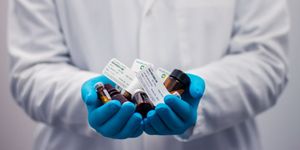Bacterial Enzyme Strips Inflammatory Carbohydrate From Meat
Humans don’t make a carbohydrate called Neu5Gc, but most mammals, including cows, do. So when people eat red meat, the Neu5Gc it contains enters the body and gets incorporated into tissues. As it builds up, the immune system identifies it as an invasive molecule and launches antibodies to fight it. This is thought to be a reason why diets rich in red meats are linked to chronic inflammation. Chronic inflammation, in turn, is associated with many diseases. Now scientists at the University of California San Diego School of Medicine have identified enzymes produced by bacteria that live in the gut that can cleave Neu5Gc from cells and release it into the bloodstream in order to reach other carbohydrates.
Reporting in Nature Microbiology, the scientists suggested that the bacterial enzymes, called sialidases, can get Neu5Gc off of human tissues or potentially, take it out before it’s ever ingested.
“It’s our hope that this approach could be used as a sort of probiotic or prebiotic to help reduce inflammation and the risk of inflammatory diseases — without giving up steak,” said the senior study author Karsten Zengler, Ph.D., a professor of pediatrics and bioengineering at UC San Diego (UCSD).
People that consume a lot of red meat are more likely to get colon cancer and atherosclerosis, and previous work has identified Neu5Gc as a culprit. The inflammatory molecule was shown to encourage tumors and atherosclerosis in a mouse model, in a study by the team of Ajit Varki, MD, Distinguished Professor of Medicine and Cellular and Molecular Medicine at UCSD School of Medicine.
In this work, humanized mice, which have been altered to model human biology more closely and are described in the video below, were used by Zengler’s team. They were investigating the impact of diet on the community of microbes in our gut, the microbiome, which plays a critical role in our health. Mice got to eat either a diet rich in meats that carried Neu5Gc, or one of two alternate diets that contained none of the molecule.
Mice that consumed the Neu5Gc-rich diet had lower levels of bacterial diversity in their microbiome, which is thought to be linked to poor health. These mice also had higher levels of certain types of bacteria than mice that didn’t eat Neu5Gc. Bacteroides, which are carbohydrate-loving bacteria, was one of the microbes that were more abundant in the mice fed Neu5Gc. A sialidase enzyme made by these bacteria was also more common, and it can get Neu5Gc off of cells.
Zengler wanted to follow up on these results in humans, but instead of a costly clinical trial, he looked to the Hadza people of Tanzania. They are known for their hunter-gatherer diet; they eat meat after hunting in the dry season and can switch to a diet of berries and honey during the warm season when they can’t hunt.
Since the Hadza have been studied by other research groups, the scientists were able to use publicly available data to learn more about the microbiomes of the Hadza. Zengler’s team determined that during the meat-eating season, there was about twice as much of the Bacteroides that carry the sialidase gene, compared to the wet season.
The researchers confirmed that an active gene was actually producing the sialidase. They also exposed meat purchased from a grocery store to sialidase that was generated in the lab and found that most Neu5Gc came off of the meat.
“The approach isn’t perfect yet — the sialidase enzyme prefers to cleave Neu5Gc, but it still cleaves a bit of a similar human carbohydrate,” said Zengler, who is also a faculty member in the Center for Microbiome Innovation at UC San Diego.
This work is ongoing; the scientists want to improve the specificity of the enzyme and find ways to mass-produce it. They want to know more about how it might help reduce inflammation and inflammatory diseases.
Sources: Phys.org via UCSD, Nature Microbiology









